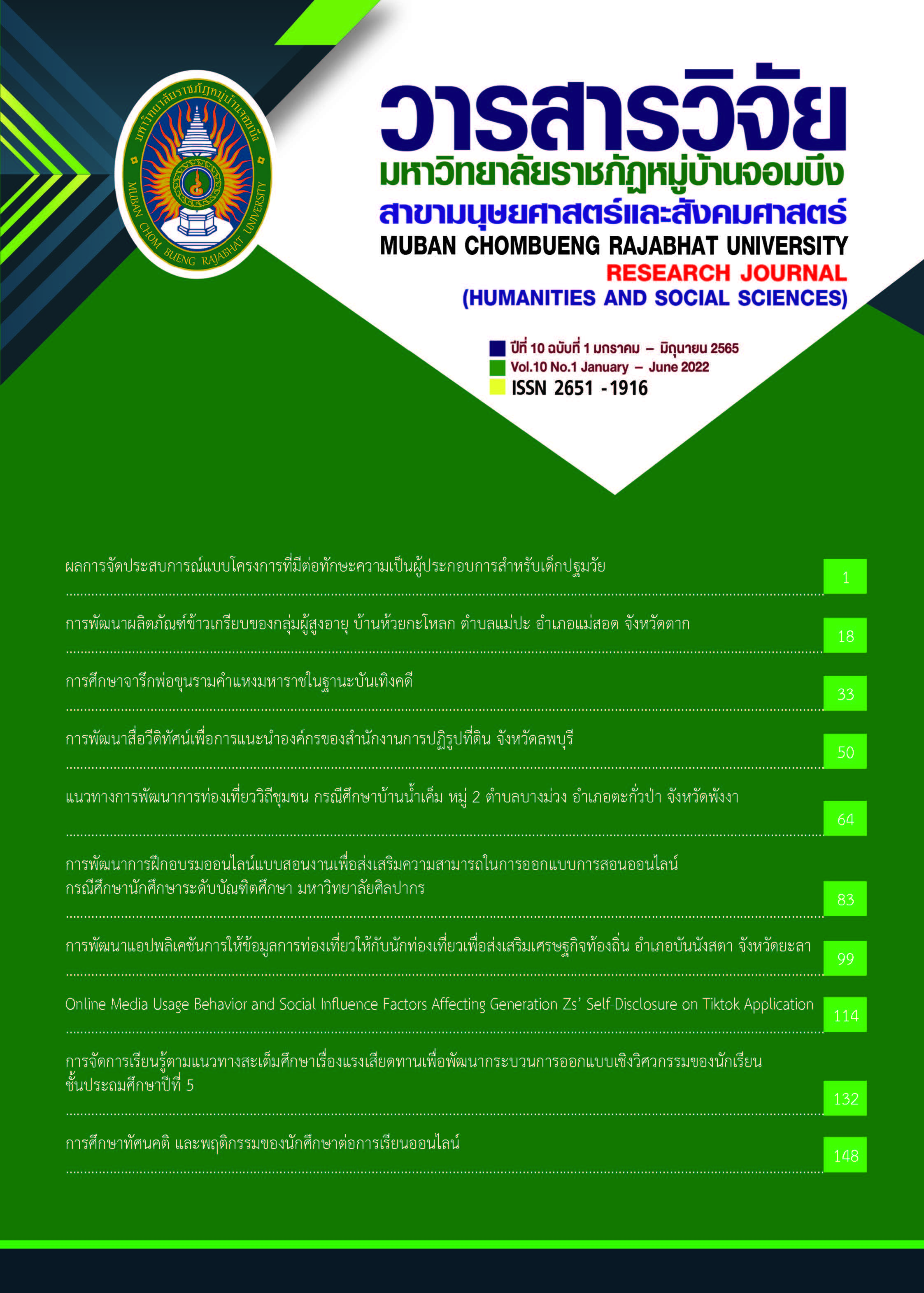การพัฒนาแอปพลิเคชันการให้ข้อมูลการท่องเที่ยวให้กับนักท่องเที่ยว เพื่อส่งเสริมเศรษฐกิจ ท้องถิ่น อำเภอบันนังสตา จังหวัดยะลา
คำสำคัญ:
การประมวลผลภาษาธรรมชาติ, การเรียนรู้ของเครื่อง, การจัดจำแนกข้อมูล, ระบบการนำทางบทคัดย่อ
งานวิจัยนี้มีวัตถุประสงค์ 1. เพื่อพัฒนาแอปพลิเคชัน ส่งเสริมการให้บริการข้อมูลการท่องเที่ยว สนับสนุนการให้คำแนะนำการท่องเที่ยวแบบอัจฉริยะ และ 2. เพื่อสร้างช่องทางการประชาสัมพันธ์แหล่งท่องเที่ยว อำเภอบันนังสตา จังหวัดยะลา โดยใช้แอปพลิเคชัน เป็นเครื่องมือใช้ยกระดับการท่องเที่ยวของพื้นที่ อีกทั้งเป็นส่วนหนึ่งที่สร้างความเชื่อมั่นให้กับนักท่องเที่ยวที่จะมาเที่ยวในพื้นที่ และช่วยกระตุ้นระบบเศรษฐกิจของพื้นที่อย่างยั่งยืนในการพัฒนาครั้งนี้ได้ใช้ทฤษฎีทางด้านการประมวลผลภาษาธรรมชาติ (Natural Languages Processing) ร่วมกับการเรียนรู้ของเครื่อง (Machine Learning) โดยใช้ การจัดจำแนกข้อความใช้เทคนิคการจำแนกข้อความด้วยวิธี Naïve Bayes
ผลการวิจัย พบว่า การวิเคราะห์ค่า Precision ได้เท่ากับ 0.61 และค่า F-measures ได้เท่ากับ 0.70 ซึ่งแสดงให้เห็นว่าการแนะนำแผนการท่องเที่ยวของระบบมีความถูกต้อง เท่ากับ 0.61 และในส่วนของความพึงพอใจของผู้ใช้ จากผู้เข้าร่วมใช้แอปพลิเคชัน จำนวน 190 คน โดยแบ่งออกเป็น 3 กลุ่ม ดังนี้ กลุ่มที่ 1 กลุ่มตัวแทนเยาวชนพื้นที่ อำเภอบันนังสตา กลุ่มที่ 2 กลุ่มนักธุรกิจที่ประกอบกิจการ การท่องเที่ยว อำเภอบันนังสตา และกลุ่มที่ 3 กลุ่มนักศึกษามหาวิทยาลัยราชภัฏยะลา โดยเฉลี่ยแล้วมีความพึงพอใจในระดับดี
เอกสารอ้างอิง
เลิศพร ภาระสกุล. (2561). Tourism behavior: Annoying behavior of Chinese tourists. Proceeding of the eighth International Conference on sports and exercise science, June, Chulalongkorn University.
K. Nokkaew and R. Kongkachandra, (2017). Semantics-based topic identification for keyphrase extraction. 12th International Conference on Knowledge, Information and Creativity Support Systems, Nagoya, Japan, on November 9-11, 138-142.
K. Nokkaew and R. Kongkachandra, (2018). Keyphrase Extraction as Topic Identification Using Term Frequency and Synonymous Term Grouping. International Joint Symposium on Artificial Intelligence and Natural Language Processing (iSAI-NLP), pp. 1-6, doi: 10.1109/iSAI-NLP.2018.8693001.
V. Sucasas, G. Mantas, S. Althunibat, L. Oliveira, A. Antonopoulos, I. Otung, J. Rodriguez, (2018). A privacy-enhanced OAuth 2.0 based protocol for Smart City mobile applications. Comput. Secur., 74, 258–274.
J. A. Diego-Mas, D. Garzon-Leal, R. Poveda-Bautista, J. Alcaide-Marzal, (2019). User-interfaces layout optimization using eye-tracking, mouse movements and genetic algorithms. Applied ergonomics, 78, 197–209, 2019.
X. Zhou, M. Su, Z. Liu, Y. Hu, B. Sun, G. Feng, (2020). Smart Tour Route Planning Algorithm Based on Na ̈ıve Bayes Interest Data Mining Machine Learning. ISPRS International Journal of Geo-Information, 9(2), 112.
Q. Ye, Z. Zhang, R. Law, (2009). Sentiment classification of online reviews to travel destinations by supervised machine learning approaches. Expert Systems with Applications, 36(3, Part 2), 6527–6535, doi:https: //doi.org/10.1016/j.eswa.2008.07.035.
A. N. Koushik, M. Manoj, N. Nezamuddin, (2020). Machine learning applications in activity-travel behaviour research: a review. Transport reviews, 40(3), 288–311.
J. Hagenauer, M. Helbich, (2017). A comparative study of machine learning classifiers for modeling travel mode choice. Expert Systems with Applications, 78, 273–282.
H.-S. Chiang, T.-C. Huang, (2015). User-adapted travel planning system for personalized schedule recommendation. Information Fusion, 21, 3–17.
ดาวน์โหลด
เผยแพร่แล้ว
รูปแบบการอ้างอิง
ฉบับ
ประเภทบทความ
สัญญาอนุญาต
ลิขสิทธิ์ (c) 2022 วารสารวิจัยมหาวิทยาลัยราชภัฏหมู่บ้านจอมบึง สาขามนุษยศาสตร์และสังคมศาสตร์

อนุญาตภายใต้เงื่อนไข Creative Commons Attribution-NonCommercial-NoDerivatives 4.0 International License.
วารสาร TCI อยู่ภายใต้การอนุญาต Creative Commons Attribution-NonCommercial-NoDerivatives 4.0 International (CC BY-NC-ND 4.0) เว้นแต่จะรุบุไว้เป็นอย่างอื่นโปรดอ่านหน้านโยบายของเราสำหรับข้อมูลเพิ่มเติมเกี่ยวกับการเช้าถึงแบบเปิด ลิขสิทธิ์ และการอนุญาต



